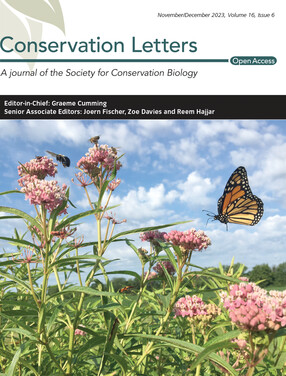入侵植物的系统发育关系是评估杂草风险的有效标准
IF 7.7
1区 环境科学与生态学
Q1 BIODIVERSITY CONSERVATION
引用次数: 0
摘要
风险评估是防止入侵物种引入的保护工具。许多评估询问一个分类单元是否有侵入性近亲,但尚不清楚这种系统发育信息是否有用,以及哪种分类尺度(如属、科)最能预测风险。将系统发育聚类分析与入侵风险预测模型相结合,我们发现入侵植物聚集在美国邻近地区的非本地植物群中。模型中的分类信息提高了模型的预测能力;同系群、同系群和姐妹群的入侵风险分别增加9%、16%和19%。系统发育信息并没有改善对没有同系物的物种或大属的物种的推断。最常见的方法——评估同属——非常适合于识别入侵者,特别是对于有2-10个已建立物种的属。虽然现有的系统发育信息可以增强入侵风险的评估,但生物学家和监管机构应该合作改善非本土物种的系统发育。本文章由计算机程序翻译,如有差异,请以英文原文为准。
Phylogenetic relationships of invasive plants are useful criteria for weed risk assessments
Abstract Risk assessments are conservation tools used to prevent the introduction of invasive species. Many assessments ask whether a taxon has invasive close relatives, but it is unclear whether this phylogenetic information is useful, and which taxonomic scales (e.g., genus, family) are most predictive of risk. Combining phylogenetic clustering analyses with models predicting invasion risk, we found invasive plants were clustered within nonnative flora of the conterminous United States. Taxonomic information in models improved their predictive capacity; invasion risk for taxa with invasive confamilials, congeners, or sister taxa increased by 9%, 16%, and 19% respectively. Phylogenetic information did not improve inference for species without any congeners, or those from large genera. The most common approach—assessing congeners—is well suited to identify invaders, particularly for genera with 2–10 established species. While existing phylogenetic information can enhance assessments of invasion risk, biologists and regulators should collaborate to improve nonnative species phylogenies.
求助全文
通过发布文献求助,成功后即可免费获取论文全文。
去求助
来源期刊

Conservation Letters
BIODIVERSITY CONSERVATION-
CiteScore
13.50
自引率
2.40%
发文量
70
审稿时长
>12 weeks
期刊介绍:
Conservation Letters is a reputable scientific journal that is devoted to the publication of both empirical and theoretical research that has important implications for the conservation of biological diversity. The journal warmly invites submissions from various disciplines within the biological and social sciences, with a particular interest in interdisciplinary work. The primary aim is to advance both pragmatic conservation objectives and scientific knowledge. Manuscripts are subject to a rapid communication schedule, therefore they should address current and relevant topics. Research articles should effectively communicate the significance of their findings in relation to conservation policy and practice.
 求助内容:
求助内容: 应助结果提醒方式:
应助结果提醒方式:


